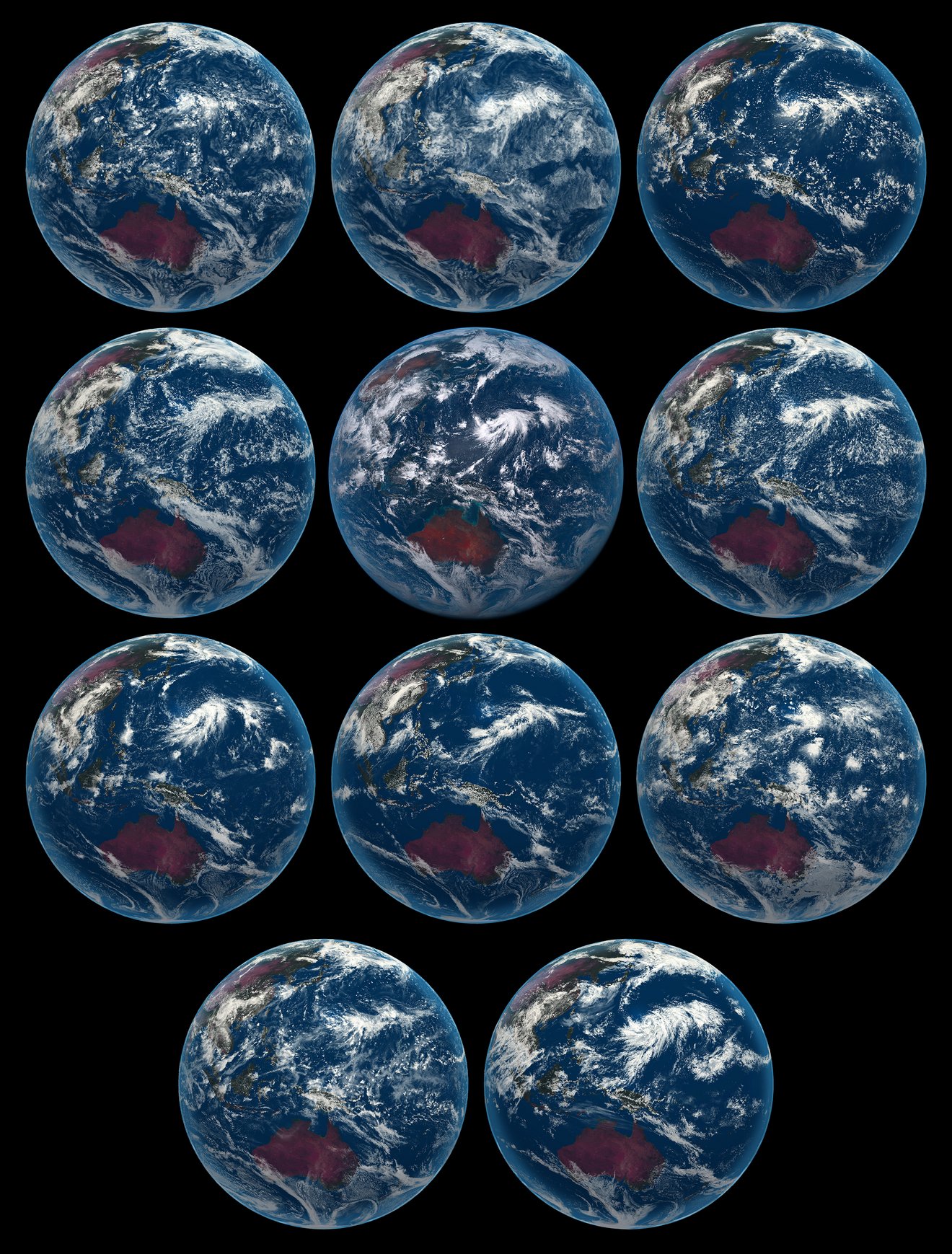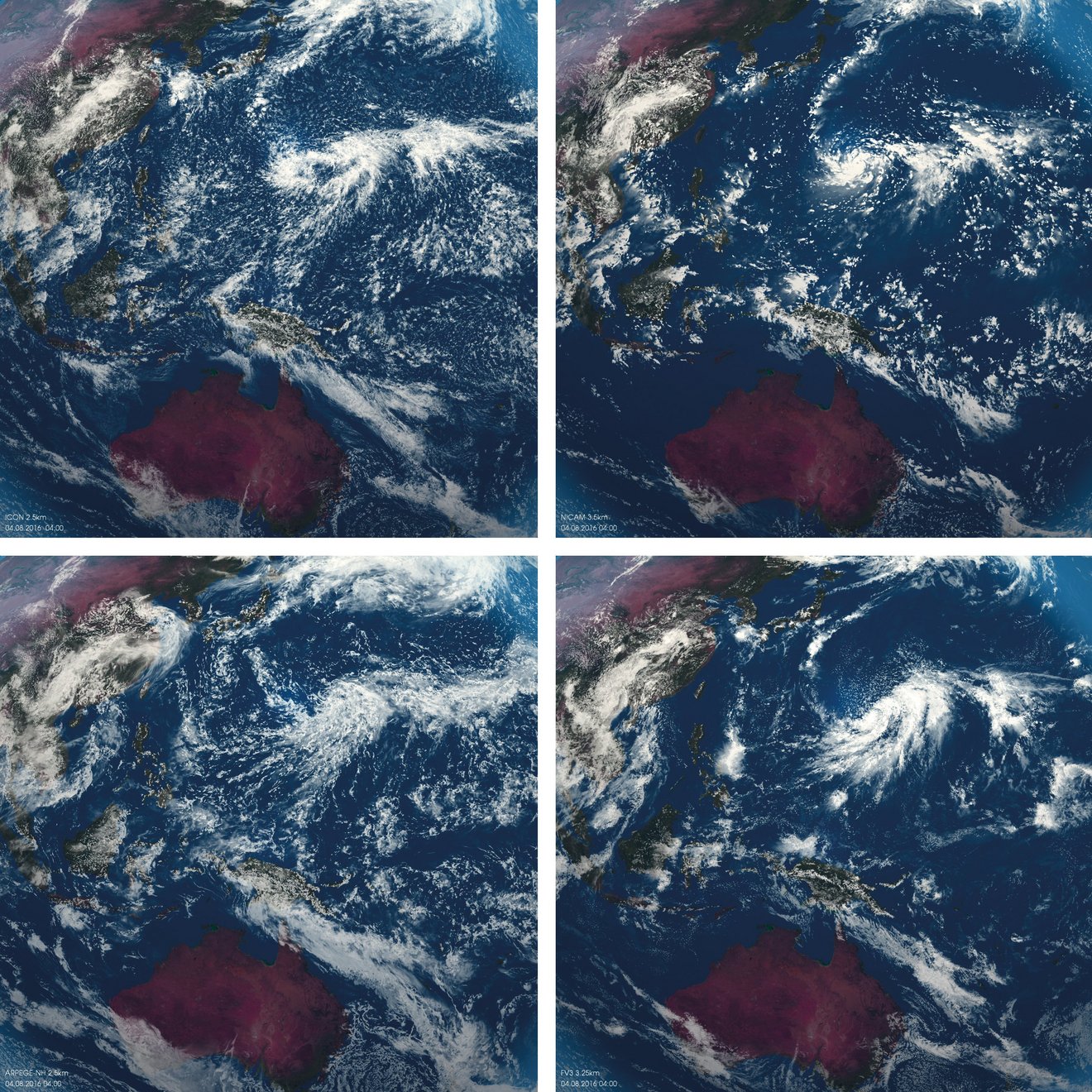DYAMOND – Next Generation Climate Models
The Max Planck Institute for Meteorology (MPI-M) has been leading the development of these GSRM. To this end, together with the University of Tokyo (an early pioneer in their development and application) MPI-M organized the first ever inte-rcomparison of such models, under the framework of the DYAMOND project. DYAMOND stands for DYnamics of the Atmospheric general circulation Modelled On Non-hydrostatic Domains and addresses two main questions: How sensitive are the simulations to a particular implementation? What are performance and analysis bottle necks associated with global storm-resolving models?
The idea of DYAMOND arose in October 2017 and started as a joint initiative between the Max Planck Institute for Meteorology (Bjorn Stevens, director and head of the department “The Atmosphere in the Earth System”) and the University of Tokyo (Professor Masaki Satoh). Further impulse was given through the involvement of US participants and the support of Germany's National Meteorological Service, Deutscher Wetterdienst (DWD), through the Hans Ertel Centre for Weather Research (HErZ) project (Daniel Klocke). Within the scope of the ESiWACE project, the German Climate Computing Center (DKRZ) agreed to host the output and serve as an analysis hub for the international climate modeling community (Joachim Biercamp).
First intercomparison of GSRM
Nine models participated in the project, each simulating forty days and forty nights of the atmosphere’s and land-surfaces evolution. Daily sea surface temperatures and global meteorological analyses by the European Centre for Medium-Range Weather Forecasts (ECMWF) were provided as initial and boundary data. The simulated period, beginning on 1 August 2016 at 00 UTC, using global models with a storm-resolving grid spacing of 5 km or less, was chosen in coincidence with the NARVAL2 airborne field campaign that was initiated and led by MPI-M. For many models this was the first time they were ever run for such a long period and for such a realistic test. The comparison allowed an evaluation of their ability to robustly represent features of the climate system. This includes the representation of convective storms and clouds, and their response to solar forcing in the form of their diurnal cycle or the location of the Intertropical Convergence Zone (ITCZ). In addition to demonstrating an ability to better simulate such global storm-resolving runs over a longer period, the simulations provided output on scales that are much more comparable to what is observed. This apparent realism is shown in figure 1, where it is difficult to distinguish the satellite image from the ten models simulating the same time period.
The simulations performed as part of DYAMOND have additionally been used to outline the technical requirements necessary to bring this type of simulation capability to bear on the evolution of the climate system over decades, and as coupled to the ocean circulation. The DYAMOND experimental protocol was kept as simple as possible, with as few specifications for the participants as possible, to encourage participation and ensure a fast turn-around. The implementation took place within a year, which is exceptional for such model intercomparisons. Nine different groups from six national entities across three continents submitted results and demonstrated that such simulations are doable nowadays.

Results
Before DYAMOND, most of the global storm-resolving models used here had never been run in this configuration, and no two models had ever before attempted to perform the same simulation. Preliminary analysis showed that basic aspects of the general circulation are well captured by the storm-resolving models. The outgoing long-wave radiation is consistent with observations, as is the global precipitation and distribution of precipitable water. Agreement among the models is such that it is difficult to establish if differences with observations—for instance, more precipitation in the poleward flank of the storm tracks and in the equatorial region just south of the Equator—represent deficiencies in the models or in the retrievals of these quantities.
Insofar as it can be determined given the brevity of the simulations and the basic storm-tracking algorithm, the tropical genesis and intensification statistics of tropical cyclones are quantitatively and qualitatively well captured. In addition, a diurnal cycle in global precipitation was identified that is consistent across all simulations and similarly evident in the observations, whereas it is inconsistent in climate models with a lower resolution. Considering that the models were not specifically tuned for this case and that minor implementation errors are to be expected given the early stage of the development, this agreement is remarkable.
The simulations are not without their deficiencies. Even the present, relatively superficial, analysis makes clear that there are still some challenges in trying to reap the rewards of being able to simulate the general circulation of Earth’s global atmosphere at storm-resolving scales.
One of the major challenges are shallow convection and stratocumulus clouds, which cannot yet be resolved by GSRM. However, they have a strong influence on the energy budget and sea surface temperatures. By virtue of the ability of GSRMs to directly link these processes to the circulation on the one hand, and observations at similar scales on the other, the scientists are optimistic that research targeted at addressing these challenges will bear fruit. If so, GSRMs will provide an improved physical foundation for model-based investigations of Earth’s climate and climate change and usher in a new generation of climate models.
Another important motivation for the DYAMOND project was to address performance and analysis bottlenecks associated with global storm-resolving models. The experiences across a variety of computer architectures with a variety of models suggest that a throughput of 6 to 10 days per day is feasible on a small 10 to 20 % of present day high-performance computers. GSRMs with up to 3 km global grids can be expected to reach a throughput of 100 simulated days per day in the coming few years. This rate of throughput makes such models applicable to a wider range of climate questions. Post-processing of the massive amounts of output from such models is challenging, both by virtue of its sheer volume and because of the more complex grid structures used by many models. In dealing with this output, domain-specific analysis tools, like CDOs (Climate Data Operators), proved to be invaluable and were optimized for the simulations.

Additional experiments
After the success of the first experiments, the participating groups of DYAMOND decided to perform additional simulations. A second set of experiments under northern hemisphere winter conditions, which will complement the boreal summer period with a winter period, have the aim of: (i) compare the representation of the Madden-Julian-Oscillation in this class of models; (ii) investigate the effect of the atmosphere-ocean coupling -- at storm and ocean-eddy resolving scales -- on convection and the general circulation, and (iii) link to the EUREC4A campaign, which targets mesoscale convection patterns and the coupling
to the upper ocean processes. As a new component in the second phase, not only experiments with atmosphere but also with coupled atmosphere-ocean models will be conducted. Many groups are actively working towards a coupled setup of the GSRM and hope to be able to contribute by the time of the experiment. The project remains open to other groups to participate and closely follows the protocol of the first DYAMOND runs.
Outlook
Project DYAMOND is working toward an intercomparison of GSRMs run on the decadal time scale. It will explore the ability of such models to better represent the atmospheric general circulation, and its sensitivity to surface temperature, as compared to traditional approaches, which use a statistical representation of major modes of convective enthalpy transport. One pressing question is whether changes in clouds, precipitation and cloud controlling factors are similar to what has been gleaned from (traditional) models of the atmospheric circulation with a coarser resolution and more highly parameterized cloud-related processes.
The simulations also provided a platform for new forms of workflow, which were explored through hackathons — short and collective programming sessions involving groups of small teams working intensively together over a period of hours to days. DYAMOND is the first jewel to arise out of the Sapphire model development project at MPI-M, and the excitement of these new horizons is already giving coherence to diverse activities through the institute.
DYAMOND publications
Brueck, M., C. Hohenegger and B. Stevens (2020) Mesoscale marine precipitation varies indepdently from the spatial arrangement from its convective cells, Quart. J. Roy. Meteor. Soc., accepted.
Hohenegger, C., L. Kornblueh, D. Klocke, T. Becker, G. Cioni, J. F. Engels, U. Schulzweida and B. Stevens, 2020: Climate statistics in global simulations of the atmosphere, from 80 to 2.5 km grid spacing. J. Meteorol. Society Japan, 98, in press, doi:10.2151/jmsj.2020-005.
Stephan, C.C., C. Strube, D. Klocke, M. Ern, L. Hoffmann, P. Preusse, and H. Schmidt (2019): Intercomparison of Gravity Waves in Global Convection-Permitting Models. J. Atmos. Sci.,76, 2739–2759, doi:10.1175/JAS-D-19-0040.1
Stevens, B., Satoh, M., Auger, L., Biercamp, J., Bretherton, C., Chen, X., Dueben, P., Judt, F., Khairoutdinov, M., Klocke, D., Kodama, C., Kornblueh, L., Lin, S.-J., Putman, W., Shibuya, R., Neumann, P., Roeber , N., Vanniere, B., Vidale, P.-L., Wedi, N. & Zhou, L. (2019). DYAMOND: The DYnamics of the Atmospheric general circulation Modeled On Non-hydrostatic Domains. Progress in Earth and Planetary Science, Vol. 6: 61, doi:10.1186/s40645-019-0304-z
Contact
Prof Dr Bjorn Stevens
Max Planck Institute for Meteorology
Phone: +49 40 41173 422 (Assistant Angela Gruber)
Email: bjorn.stevens@mpimet.mpg.de
Dr Cathy Hohenegger
Max Planck Institute for Meteorology
Phone: +49 40 41173 302
Email: cathy.hohenegger@mpimet.mpg.de
Dr Daniel Klocke
Deutscher Wetterdienst (DWD) – Hans-Ertel-Centre (HErZ)
Phone: +49 69 8062 3051
Email: daniel.klocke@dwd.de


